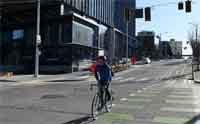| |
|
| |
|
 |
Supply
Chain by the Numbers |
| |
|
| |
- Aug. 13, 2020 -
|
| |
|
| |
|
| |
|
| |
Nikola Motors with Huge Deal for Electric Trucks; Big New Surcharges Coming for UPS Customers; FedEx Finding Robot Success for Hub Sorting; Retail Chains Pulling Out of Empty Manhattan |
| |
|
| |
| |
| |
| |
2500 |
 |
That's how many Nikola Motors all electric trash trucks were ordered by waste-disposal company Republic Services, in what Republic claims to be the first large-scale commitment to fleet electrification in its industry, in news this week. On-road testing is scheduled to begin in 2022, with full production "shortly after," Nikola said. Republic expects to take delivery of the first trucks in 2023, and has an option to expand the order to 5,000 units. Based on the Nikola Tre model, the trucks will have a range of 150 miles, sufficient enough make about 1,200 collection stops, Republic will recharge the battery overnight, Nikola said. The battery-electric powertrain provide1,000 horsepower, which Nikola says is three times the power of natural-gas and diesel trucks. This huge order is "providing early elements of validation" for the newly public electric vehicle maker, Deutsche Bank said Tuesday. In a note to clients, the firm re-iterated its short-term buy rating on shares, saying the company is likely to announce additional key milestones and partnerships over the coming months.
|
|
|
| |
| |
|
|
|
That is the surcharge per parcel UPS announced this week that it will apply this peak season on some shipments, as the large parcel carriers continue to flex their pricing muscles in the face or soaring ecommerce delivery demand. UPS customers that send more than 25,000 packages a week to consumers will have to pay additional surcharges of $1-$4 per package if they exceed their forecast volumes. The fees will apply to ground residential and SurePost shipments, next day air residential and other air shipments to residences. A higher $3-$4.00 per package surcharge will be applied to big customers that ship more than 200% or 300% of their February 2020 volume during the height of the holiday shipping and returns period from Nov. 15 - Jan. 16. UPS already has peak surcharges of 30 cents per package through Nov. 14 on ground residential shipments from those large corporate customers shipping significantly more packages. But you can always negotiate. |
| |
| |
|
| |
| |
$937,000 |
 |
That is the monthly rent on the retail space occupied by the Victoria's Secret flagship store at Herald Square in Manhattan. There is just one problem: the store has been closed for four months and is not paying that rent. "It will be years before retail has even a chance of returning to New York City in its pre-Covid form," the retailer's parent company recently told its landlord in a legal document. The DNYUZ web site this week reported that many retail chains have either closed stores in Manhattan for good or not opened locations there back up even as they did so in many other areas of the country. It added that "In Manhattan's major retail corridors, from SoHo to Fifth Avenue to Madison Avenue, once packed sidewalks are now nearly empty. A fraction of the usual army of office workers goes into work every day, and many wealthy residents have left the city for second homes." Restaurants in the city are in just as bad of shape. The Big Apple may just never be the same. |
| |
| |
| |
| |
| |
|
|
|
| |
 |
 |
| |
 |
![]() |
 |
|
| |
 |
Feedback |
|
|
|
![]()
|
No Feedback on this article yet.
|
|
![]() |
|
|
|
![]() |
 |
![]() |
 |
|
| |